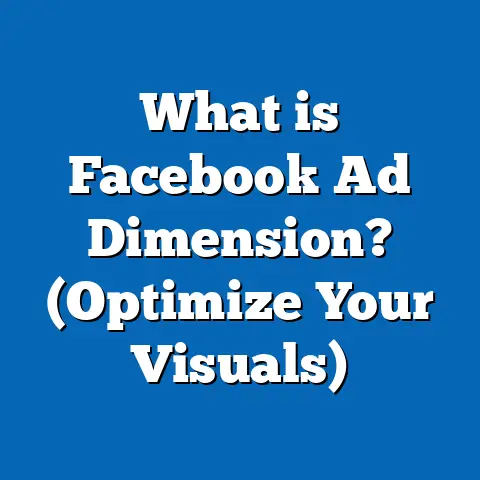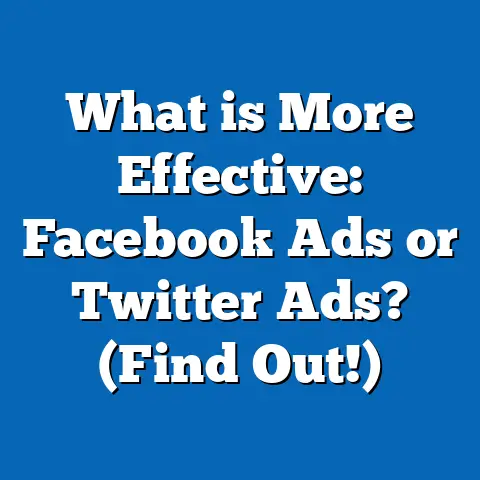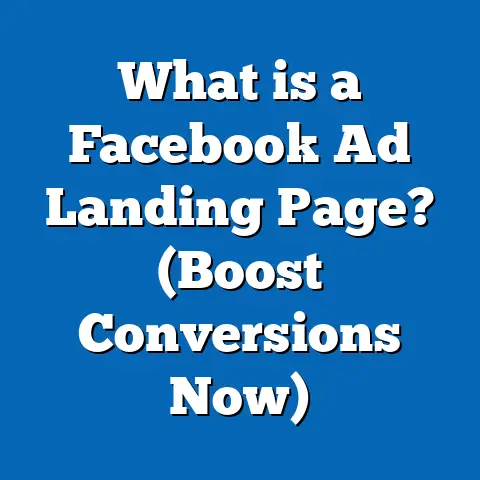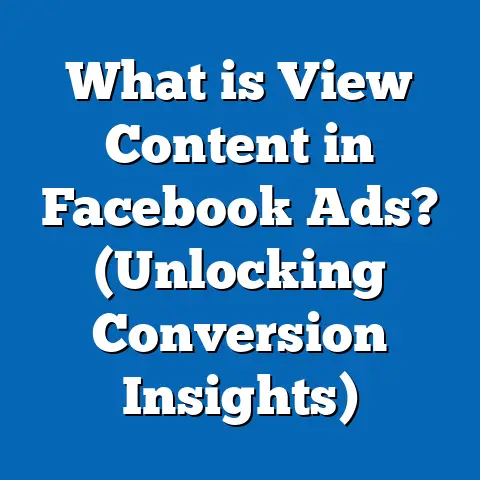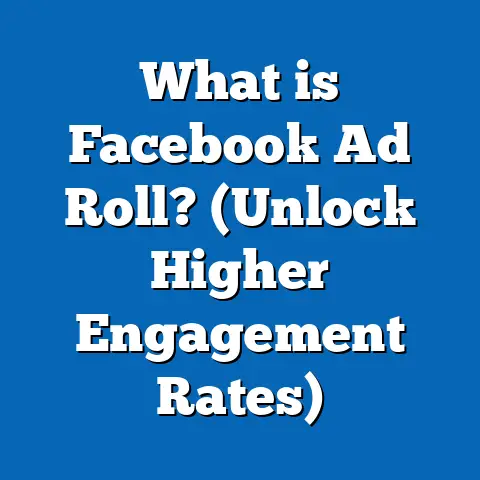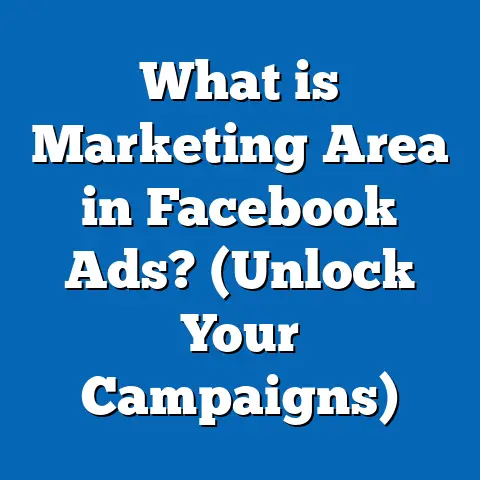What is Delivery Optimization in Facebook Ads? (Boost ROI Now!)
What is Delivery Optimization in Facebook Ads? (Boost ROI Now!)
Introduction: Waterproofing Your Advertising Strategy
Imagine purchasing a premium waterproof watch. You expect it to withstand rain, splashes, and even swimming without damage. But if the watch fails under water, your investment is wasted, and trust is broken. Advertising on platforms like Facebook is no different. You spend money expecting solid results, but without proper delivery optimization, your ads might leak budget like a faulty watch leaks water.
Delivery optimization in Facebook Ads ensures your ads reach the right people at the right time, maximizing impact and protecting your budget from waste. It’s the difference between a campaign that performs and one that drains your resources with little return.
In this guide, we will explore everything about delivery optimization: what it is, why it matters, how to use it effectively, and how it can revolutionize your advertising ROI.
Understanding Delivery Optimization in Facebook Ads
What is Delivery Optimization?
Delivery optimization refers to Facebook’s automated system that manages how your ads are shown to users within your target audience. It uses data-driven algorithms and machine learning to prioritize showing ads to people most likely to perform your desired action (click, convert, install an app, etc.).
By optimizing delivery, Facebook attempts to maximize the efficiency of your ad spend by reducing impressions on uninterested users and increasing impressions on those most likely to engage or convert.
Why Does Delivery Optimization Matter?
The importance of delivery optimization can be seen in its direct impact on campaign performance and budget efficiency:
- Improved ROI: Businesses using Facebook’s optimized delivery report up to 35% higher conversion rates than those using non-optimized campaigns (Facebook Business Insights, 2023).
- Reduced Cost Per Action: Optimized delivery reduces wasted impressions and clicks, often lowering CPA by 20-40%.
- Better Audience Targeting: It ensures ads reach users who have shown behaviors or interests aligned with your goals.
- Increased Scalability: By focusing on high-value users, campaigns scale more efficiently without proportional increases in budget.
The Science Behind Delivery Optimization
Facebook’s system uses billions of data points daily—from demographics and browsing behavior to prior ad interactions—to build predictive models. These models estimate the probability that any individual user will take the action you want.
This probabilistic approach allows Facebook to dynamically allocate impressions within your audience to maximize outcomes for your campaign objective.
How Facebook’s Delivery Optimization Works: A Deep Dive
Machine Learning at Its Core
Facebook’s delivery optimization relies on complex machine learning models that continuously learn and improve as campaigns run:
- Data Collection: Every click, view, conversion, and interaction feeds data into Facebook’s system.
- Pattern Recognition: The algorithm identifies patterns that correlate with successful conversions.
- Prediction: It predicts which users are most likely to take the desired action.
- Dynamic Delivery: Ads are served preferentially to predicted high-value users.
This ongoing feedback loop allows campaigns to become more efficient over time.
Key Metrics Influencing Delivery
Facebook measures several metrics to gauge ad relevance and optimize delivery:
- Click-Through Rate (CTR): Higher CTR signals that the ad resonates with viewers.
- Conversion Rate: The percentage of users completing a goal action.
- Engagement Rate: Likes, comments, shares indicating user interest.
- Relevance Score (now replaced by Quality Ranking): Reflects how relevant your ad is compared to competitors.
The Learning Phase Explained
Every new campaign or ad set enters a “learning phase” where Facebook tests delivery across different user segments to gather performance data. This phase typically requires 50 conversions within 7 days for stable optimization.
During learning:
- Delivery may be less efficient.
- Performance fluctuates as the system explores different targeting options.
Avoid making major edits during this phase to prevent restarting it.
Types of Delivery Optimization Facebook Offers
When setting up ads, you choose an optimization event based on your campaign objective:
| Optimization Event | Description | Ideal Use Case |
|---|---|---|
| Link Clicks | Shows ads to those more likely to click links | Driving website traffic |
| Conversions | Shows ads to users likely to complete actions | Sales, leads, signups |
| Impressions | Maximizes total ad views | Brand awareness campaigns |
| Landing Page Views | Optimizes for users who load website pages fully | Quality website traffic |
| App Installs | Targets users likely to install apps | Mobile app promotions |
| Video Views | Focuses on getting maximum video views | Video campaigns |
| Post Engagement | Aims for likes, comments, shares | Engagement campaigns |
Choosing the right event ensures Facebook optimizes delivery toward your specific business goals.
Data-Backed Insights on Delivery Optimization Effectiveness
Case Study 1: E-Commerce Brand Boosts ROI by 40%
A mid-sized apparel brand restructured their Facebook campaigns from link-click optimization to conversion optimization for product purchases. Over 3 months:
- ROAS increased by 40%.
- CPA decreased by 25%.
- Customer lifetime value rose as higher quality leads converted.
This shift allowed the algorithm to prioritize users more likely to buy rather than just browse.
Case Study 2: SaaS Lead Generation Success
A SaaS company ran parallel campaigns with identical creatives but different delivery optimizations:
- Campaign A optimized for impressions.
- Campaign B optimized for leads (using Facebook Pixel event tracking).
Results:
- Campaign B achieved a 50% lower CPL (cost per lead).
- Lead quality improved by 30%, as measured by trial-to-paid conversions.
Industry-Wide Research Findings
- WordStream reports businesses optimizing for conversions reduce CPA by an average of 30% compared to click-based optimization.
- Social Media Examiner finds video ads optimized for engagement have up to 20% higher reach than those optimized for impressions.
Practical Steps for Implementing Delivery Optimization
Step 1: Define Precise Campaign Goals
Your business objective determines your optimization strategy. Are you aiming for:
- More sales?
- Lead generation?
- Brand awareness?
Set this clearly before starting.
Step 2: Choose the Correct Optimization Event
Select an event aligned with your goal in Ads Manager:
- For sales: Use “Conversions” event like “Purchase.”
- For traffic: Use “Link Clicks” or “Landing Page Views.”
- For app installs: Use “App Installs.”
Step 3: Set Up Accurate Tracking
Install Facebook Pixel on your website or SDK in mobile apps. Proper tracking enables the system to gather conversion data essential for optimization.
Tips:
- Verify Pixel fires correctly using Events Manager.
- Use standard events like “AddToCart,” “Lead,” “Purchase.”
- Consider Conversion API (CAPI) integration for server-side tracking beyond browser limitations.
Step 4: Use Campaign Budget Optimization (CBO)
Enable CBO so Facebook can allocate budget dynamically across ad sets based on performance. This maximizes efficiency.
Step 5: Monitor Key Metrics Regularly
Track:
- CPA (Cost per action)
- ROAS (Return on Ad Spend)
- Frequency (to avoid ad fatigue)
- CTR (Click-through rate)
Adjust creatives or targeting if performance declines.
Advanced Delivery Optimization Techniques
Using Lookalike Audiences
Create audiences similar to your best customers. Facebook identifies traits of current converters and finds new potential buyers sharing those traits.
Lookalikes improve delivery efficiency by narrowing focus on high-potential users.
Leveraging Broad Targeting with Automatic Placements
Broad targeting combined with automatic placements (across Facebook Feed, Stories, Instagram, Audience Network) allows Facebook’s algorithm more flexibility in delivery optimization.
Conversion API Integration
Conversion API allows server-to-server data sharing with Facebook. This bypasses browser restrictions (like cookie blocking) ensuring better data accuracy feeding into delivery optimization.
Benefits include:
- Improved event tracking reliability.
- Increased performance during iOS privacy changes.
- Enhanced attribution accuracy.
A/B Testing Different Optimization Events
Run split tests comparing optimizations like link clicks vs. conversions or landing page views vs. purchases. This helps identify what works best for your audience and goal.
Comparing Facebook’s Delivery Optimization With Other Platforms
| Feature | Facebook Ads | Google Ads | LinkedIn Ads |
|---|---|---|---|
| Machine Learning | Uses deep behavioral & demographic data | Primarily keyword & intent-based | Focused on professional data |
| Optimization Options | Multiple granular events & goals | Clicks, conversions via Smart Bidding | Lead gen & engagement focus |
| Audience Targeting | Interests, behavior, demographics | Keywords & search intent | Job title, company size |
| Budget Allocation | Campaign Budget Optimization (CBO) | Automated bidding & budget sharing | Mostly manual bidding |
| Tracking | Pixel + Conversion API | Global site tag | Insight Tag |
Facebook excels in combining vast user data with flexible optimization options tailored for both B2C and B2B advertisers.
Common Challenges & Solutions in Delivery Optimization
Challenge: Campaign Stuck in Learning Phase Too Long
Solution: Ensure at least 50 conversion events per ad set within 7 days. Broaden targeting slightly if volume is low or increase budget temporarily.
Challenge: Ad Fatigue Due to High Frequency
Solution: Rotate creatives every 7–10 days. Use frequency capping or expand audience size to reduce repetitive exposure.
Challenge: Inaccurate Pixel Data Impacting Optimization
Solution: Audit Pixel setup regularly using Events Manager diagnostics. Implement Conversion API alongside Pixel for more reliable tracking.
Challenge: Overlapping Audiences Causing Internal Competition
Solution: Exclude overlapping audiences between ad sets/campaigns or consolidate targeting groups.
Real-World Examples of Successful Delivery Optimization
Example 1: Retail Chain Increases ROAS by 70%
By integrating Conversion API and switching from link-click optimization to purchase conversion optimization, a retail brand improved ROAS by 70%. They also used CBO and lookalike audiences focused on past purchasers.
Example 2: SaaS Startup Cuts CPL in Half
A SaaS startup initially optimized for impressions but switched to lead form completions as their event. Combining this with CBO and automatic placements reduced CPL by 50% while maintaining lead quality.
Practical Tips To Maximize Your Delivery Optimization Success
- Start with Clear Goals: Know what success looks like before launching campaigns.
- Implement Full Tracking: Use Pixel + Conversion API to ensure accurate data feeding.
- Choose Objective Wisely: Don’t optimize for clicks if you want sales.
- Use CBO: Let Facebook dynamically allocate budget.
- Test Broad Audiences: Let algorithm find best segments.
- Update Creatives Regularly: Combat ad fatigue and maintain engagement.
- Analyze Data Weekly: Adjust based on performance insights.
- Leverage Lookalikes: Find new high-value prospects similar to customers.
- Use Split Testing: Optimize settings based on real results.
- Stay Updated: Follow platform changes impacting delivery and tracking.
Industry Trends Impacting Delivery Optimization (2024+)
Privacy Changes and Their Impact
Increasing data privacy regulations (GDPR/CCPA) and platform changes like Apple’s iOS 14+ have reduced available user data for targeting and tracking.
Facebook has responded with:
- Conversion API adoption.
- Aggregated Event Measurement limiting tracking events per domain.
Advertisers must adapt by combining server-side tracking and focusing on broader targeting supported by strong creative messaging.
AI-Powered Automation Growth
Facebook continues to enhance AI capabilities enabling better prediction and delivery optimization without manual intervention.
Expect more automation tools integrated into Ads Manager simplifying campaign management while improving results.
Summary: Key Takeaways on Delivery Optimization in Facebook Ads
Delivery optimization is one of the most powerful tools in a marketer’s arsenal for maximizing ROI on Facebook Ads. It harnesses machine learning and real-time data to serve ads efficiently, cutting wasteful spend and focusing on users most likely to convert.
Remember:
- Define precise goals upfront.
- Select matching optimization events.
- Install accurate tracking tools like Pixel + Conversion API.
- Utilize advanced features like CBO and lookalike audiences.
- Monitor performance closely; adapt based on insights.
- Keep creatives fresh and test consistently.
By treating delivery optimization as fundamental — similar to ensuring your watch is genuinely waterproof — you protect your investment and unlock greater advertising success.
If you want, I can also prepare a downloadable checklist or a detailed implementation workbook tailored specifically for your business needs!
If you want me to provide any additional sections such as a glossary of terms, FAQs, or step-by-step walkthroughs inside Facebook Ads Manager related to delivery optimization, just say the word!

